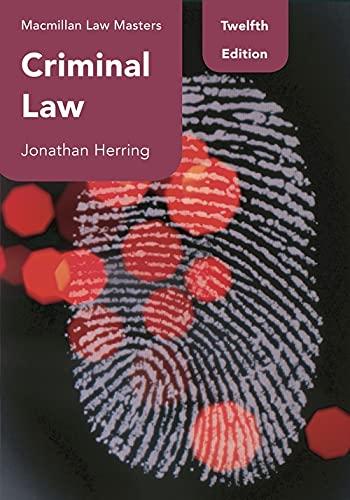Question
Reply to peers post Peer 1 The recognition of hate crimes was crucial in the establishment of the legislation. Consequently, 46 states and the District
Reply to peers post
Peer 1
The recognition of hate crimes was crucial in the establishment of the legislation. Consequently, 46 states and the District of Columbia have enacted various criminal legislation. These legislation permitted the extension of the criminals' sentences. The drawbacks encompass the intricacies of the legislation, wherein some accusations were only enforceable when the wrongdoer had a collaborator. Additionally, it resulted in the establishment of the initial substantial criminal legislation enacted at the national level, namely the Hate Crime Statistics Act of 1990. This law was employed to gather information on offenses associated with race, religion, sexual orientation, or nationality. In September 1994, Congress approved the Violent Crime Control and Law Enforcement Act, which expanded the scope of the Hate Crime Statistics Act to include both physical and mental disability. The heinous killings of James Byrd Jr. and Matthew Shepard throughout the 1990s were the catalyst for the implementation of hate crime laws. Regrettably, prior to these instances of hate crime homicides, the concept of hate crime was not well known, thereby resulting in increased awareness within the United States. Further factors that influenced this consciousness and the African American community were endorsements from prominent figures like Jesse Jackson, Senator Kay Bailey Hutchinson, and a correspondence from former President Bill Clinton. According to the FBI's Uniform Crime Reporting (UCR) data for 2022, there were a total of 11,634 hate crime events, with 59.1 percent of these being tied to race or ethnicity. Thus, hate crime law has not exhibited any progress in comparison to its initial establishment in the 1990s (Facts and Statistics, 2024). Considering the historical prevalence of hate crimes and the underlying principles that drive them, it is imperative to treat the repercussions of such crimes with more gravity. Implementing rules that approach zero-tolerance can help prevent the perpetuation of this mindset across generations. An instance of adopting a more earnest approach towards this infraction may be observed in the National Crime Victimization Survey (NCVS), which, before to 2003, did not inquire victims about their perception of whether the crime committed against them was motivated by bias. In addition, the statistics dated 2017. showed comparable figures for the race/ethnicity proportion as the previously cited 2022 data.
References:
Alvarez, A., & Bachman, R. D. (2024). Violence: The enduring problem. SAGE PUBLICATIONS INC
Peer 2
These crimes are abhorrent acts characterized by a deep-seated animosity against an individual or a certain group, leading to the belief that it is acceptable to engage in violent behavior or pose threats to their safety. Hate crimes have a long history, but it was only in the late 1980s that the concept of hate crime legislation was introduced to Congress through the case Wisconsin vs Mitchell. In this case, the Court affirmed the legitimacy of hate crime legislation, which imposes harsher penalties for crimes motivated by a victim's protected characteristics, such as race. The case of Wisconsin v. Mitchell is referred to. A study conducted by revealed a significant rise in crimes committed against individuals based on their ethnicity, religion, sexual orientation, and other factors. The aforementioned case served as the catalyst for the enactment of the Hate Crimes Statistics Act. This legislation mandated the attorney general to gather information on crimes that exhibited characteristics of a hate crime. The primary objectives were to enhance the capacity to address hate crimes, collect relevant data, and raise awareness about hate crimes as a whole. The source of this information is Hate Crime Statistics, n.d.
Reference
About hate crime statistics. (n.d.). FBI. https://ucr.fbi.gov/hate-crime/2010/resources/hate-crime-2010-about-hate-crime
Bakken, T. (2002). The Effects of Hate Crime Legislation: Unproven Benefits and Unintended Consequences. International Journal of Discrimination and the Law, 5(4), 231-246. https://doi.org/10.1177/135822910200500404
Step by Step Solution
There are 3 Steps involved in it
Step: 1

Get Instant Access to Expert-Tailored Solutions
See step-by-step solutions with expert insights and AI powered tools for academic success
Step: 2

Step: 3

Ace Your Homework with AI
Get the answers you need in no time with our AI-driven, step-by-step assistance
Get Started


